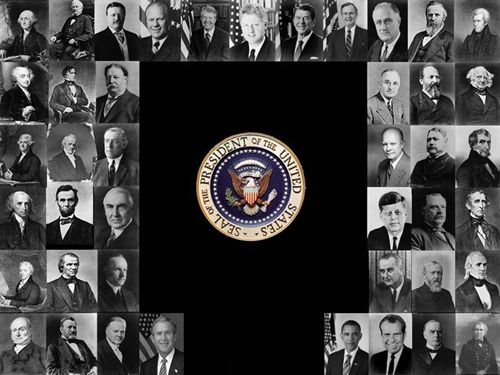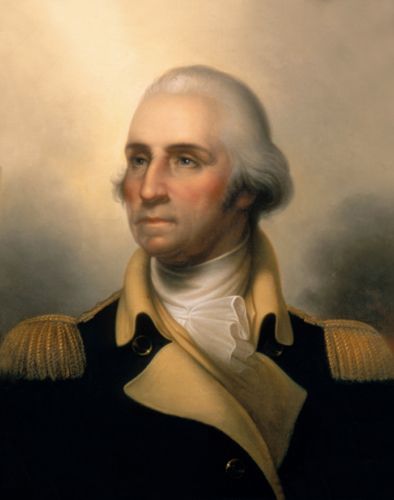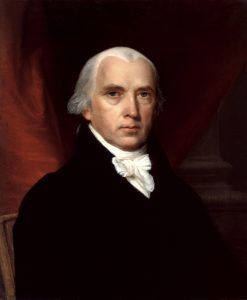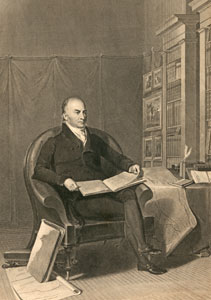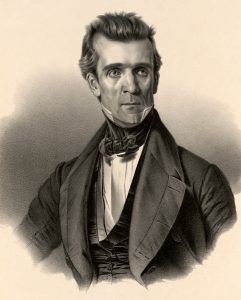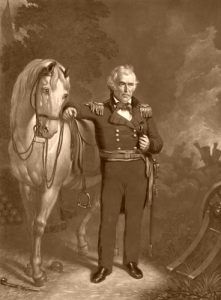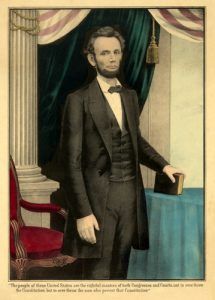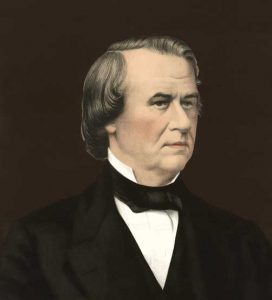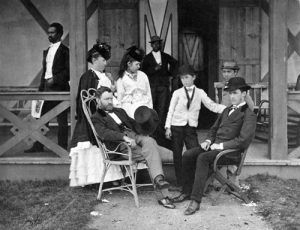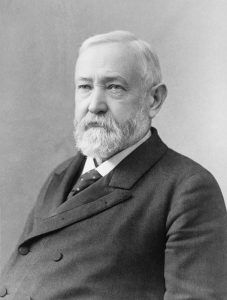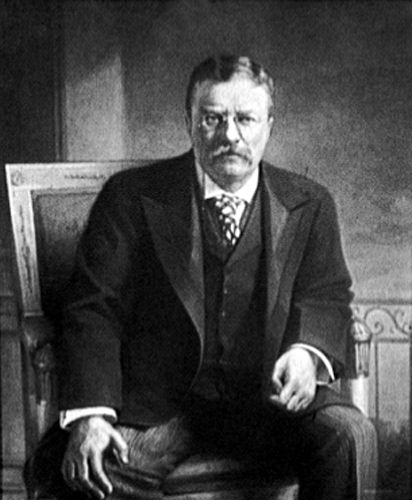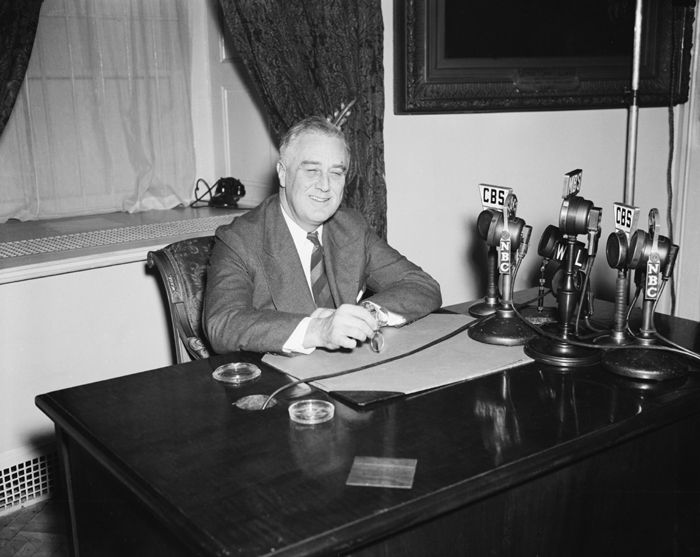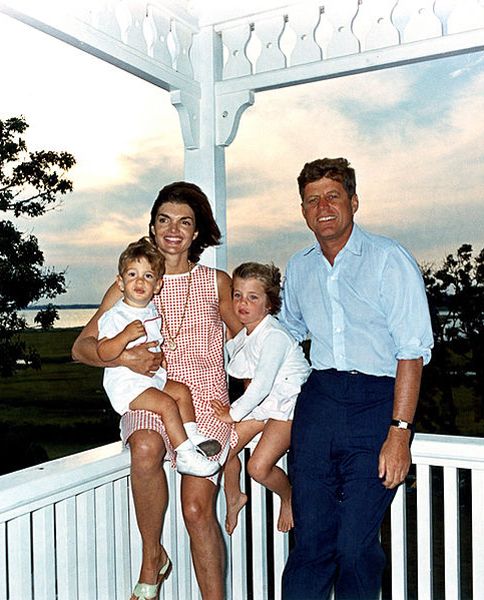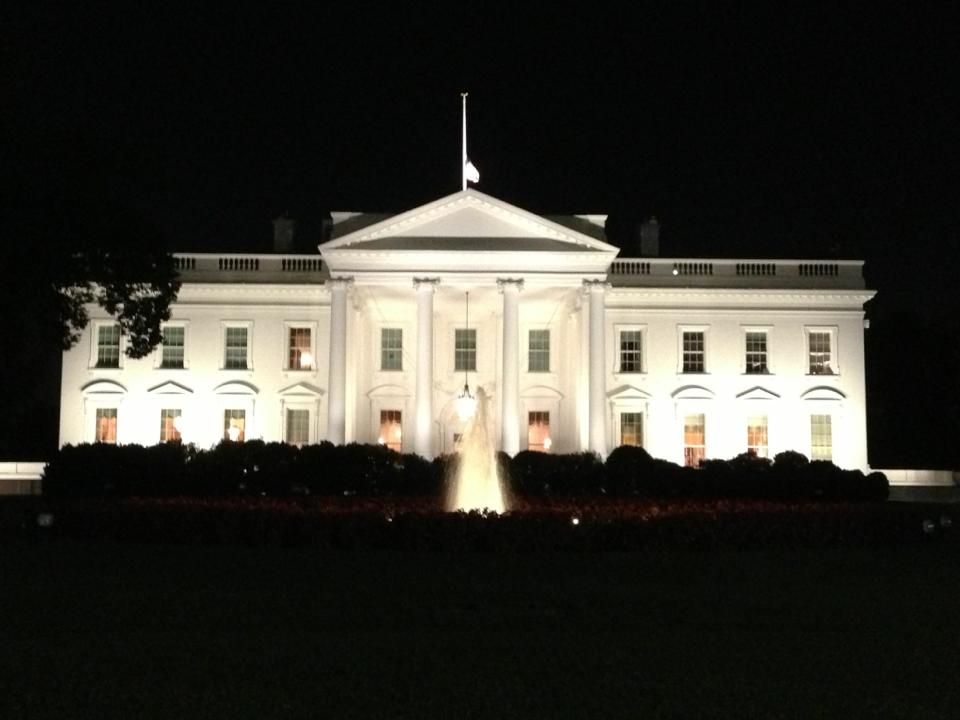“The presidency has made every man who occupied it, no matter how small, bigger than he was; and no matter how big, not big enough for its demands.”
— Lyndon B. Johnson
Presidents (See Below)
President Abraham Lincoln’s Gettysburg Address
President Franklin D. Roosevelt’s “Infamy Speech”
The Presidential Election of 1800
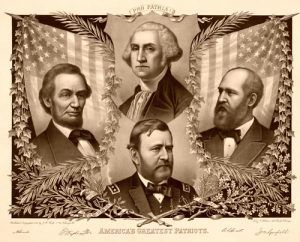
America’s Greatest Patriots – Presidents George Washington, Abraham Lincoln, William McKinley, and James Garfield, by Kurz and Allison, 1890.
Presidents:
George Washington – Father of Our Country – (1732-1799)
Term (1789-1797) Vice President – John Adams (1789-1797)
First President of the United States, Founding Father, and Commander of the Continental Army in the American Revolution. He presided over the writing of the Constitution in 1787.
John Adams – Founding Father & 2nd U.S. President (1735-1826) –
Term (1797-1801) Vice President –Thomas Jefferson (1797-1801)
Vice President to George Washington, 2nd U.S. President, and Founding Father of the United States.
Thomas Jefferson — The Sage of Monticello (1743-1826)
Term (1801-1809) Vice President(s) Aaron Burr (1801-1805), George Clinton (1805-1809)
The third President of the United States and principal author of the Declaration of Independence, he is known for his promotion of the ideals of republicanism in the United States. He is considered one of the most influential Founding Fathers.
Also See: Thomas Jefferson – The True Father of American History
James Madison (1751-1836)
Term (1809-1817) Vice President(s) George Clinton (1809-1812) None (1812-1813) Elbridge Gerry (1813-1814) None (1814-1817)
Politician, political philosopher, 4th President of the United States, and one of the country’s Founding Fathers. He was instrumental in writing the Constitution and wrote the Bill of Rights. As a leader in the House of Representatives, Madison worked closely with President George Washington to organize the new federal government. As Thomas Jefferson’s Secretary of State (1801–1809), he supervised the Louisiana Purchase, doubling the nation’s size. A series of disasters at the beginning of the War of 1812 damaged his reputation, but by 1814–15 American forces repulsed major British invasions, and he recovered.
James Monroe (1758-1831)
Term (1817-1825) Vice President Daniel D. Tompkins (1817-1825)
The 5th President of the United States and the last Founding Father to become a U.S. President. He is most noted for his proclamation in 1823 of the Monroe Doctrine, which stated that the United States would not tolerate further European intervention in the Americas.
John Quincy Adams (1767-1848)
Term (1825-1829) Vice President John C. Calhoun (1825-1829)
The son of Founding Father John Adams, he was a politician, diplomat, and the 6th President of the United States. Historians agree he was one of the great diplomats in American History. Adams had previously served as an ambassador to several European countries and a U.S. senator from Massachusetts. He is the only president in history to serve in the U.S. House of Representatives after leaving the presidency. Adams’s fierce sense of independent judgment meant that he never completely fit the mold of any political party, and he was undoubtedly the only president to have a pet alligator in the White House!
Andrew Jackson – (1767-1845)
Term (1829-1837) Vice President(s) John C. Calhoun (1829-1832), None (1832-1833) Martin Van Buren (1833-1837)
The 7th President of the United States also served as the military governor of pre-admission Florida and commander of the American forces at the Battle of New Orleans in the War of 1812. He dominated American politics in the 1820s and 1830s and helped shape the Democratic Party.
Martin Van Buren (1782-1862)
Term (1837-1841) Vice President Richard M. Johnson (1837-1841)
The 8th President of the United States, he also served as Vice President to Andrew Jackson. He was a key organizer of the Democratic Party and the first president to be born an American citizen. As the descendant of Dutch immigrants, he was also the first president whose ethnic background wasn’t mainly from the British Isles. He was best known for his shrewd political skills. He considered himself a follower of Thomas Jefferson and was one of the founders of the Democratic Party.
William Henry Harrison (1773-1841)
Term 1841 Vice President John Tyler (1841)
The 9th President of the United States, military officer, and politician, he was the first president to die in office. He had the shortest tenure in presidential history. As an Army officer and governor of the territory now Indiana and Illinois, he fought Indians. He made harsh treaties with them, clearing the way for more westward settlement by whites. His military victories against Indians made him a hero to white Americans. Harrison’s father, Benjamin Harrison, signed the Declaration of Independence. William Henry Harrison’s grandson, Benjamin Harrison, became the 23rd president.
John Tyler (1790-1862)
Term (1841-1845) Vice President –None
The 10th President of the United States, he was the first to succeed in office following the death of a predecessor. As president, he stood against his party’s platform and vetoed several of their proposals, resulting in most of his cabinet resigning and the Whigs expelling him from their party. His most notable achievement was annexing the Republic of Texas in 1845. Tyler had other “firsts” as president: His first wife was the first wife to die while her husband was still president, and he was the first president to marry while in office. Tyler was the last of the Virginia aristocrats in the White House. He was a Southerner until his death, even being elected to the Confederate Congress after unsuccessfully trying to keep the Union from dissolving and entering the Civil War. He was the only president who also allied himself with the Confederacy.
The best years of your life are the ones in which you decide your problems are your own. You do not blame them on your mother, the ecology, or the president. You realize that you control your own destiny.
— Albert Ellis
James K. Polk (1795-1849)
Term (1845-1849) Vice President George M. Dallas (1845-1849)
The 11th President of the United States, Polk also served as Speaker of the House and Governor of Tennessee. Polk was the last strong pre-Civil War president and was noted for his foreign policy successes. Scholars have ranked him favorably on the list of greatest presidents for his ability to set an agenda and achieve all of it. Polk was too sick as a child to get formal schooling, yet he managed to graduate at the top of his class from the University of North Carolina when he was 22. He was nicknamed “Napoleon of the Stump” for his excellent speaking skills. Polk was a very hard-working chief executive who proved to be one of the most productive presidents in history. He greatly expanded the U.S. territory and re-established the independent treasury system, among many other accomplishments. Upon election, he vowed to serve only one term, a promise he kept when he declined to run in 1848.
Zachary Taylor (1784-1850)
Term (1849-1850) Vice President
Distinguished general and 12th President of the United States, Taylor served in the War of 1812 and the Mexican-American War, where he earned the nickname “Old Rough and Ready.” He was elected president in 1848, the first never to have held any previous elected office. He was also the last President to hold slaves while in office. Just two years into his presidency, he died.
Millard Fillmore (1800-1874)
Term (1850-1853) Vice President – None
The 13th President of the United States, he assumed the presidency after the death of Zachary Taylor. After serving out Taylor’s term, he failed to gain the nomination for re-election.
Franklin Pierce (1804-1869)
Term (1853-1857) Vice President William King (1853), None (1853-1857)
Politician, lawyer, soldier, and 14th U.S. President Pierce was a brigadier general in the Mexican-American War. As president, he made many divisive decisions that were widely criticized, earning him a reputation as one of the worst presidents in U.S. history. His popularity fell after he came out in favor of the Kansas-Nebraska Act, repealing the Missouri Compromise, and renewed the debate over expanding slavery in the West. He lost the nomination for re-election.
James Buchanan (1791-1868)
Term (1857-1861) Vice President John C. Breckinridge (1857-1861)
The 15th U.S. President, politician, and attorney was often called a “doughface,” meaning a Northerner with Southern sympathies. Buchanan’s efforts to maintain peace between the North and the South alienated both sides, and the Southern states declared their secession. His inability to impose peace on sharply divided partisans on the brink of the Civil War has led to his consistent ranking by historians as one of the worst Presidents.
Abraham Lincoln (1809-1865)
Term (1861-1865) Vice President(s) Hannibal Hamlin (1861-1865), Andrew Johnson (1865)
Pioneer, attorney, and 16th U.S. President, he guided this country through the most devastating national experience- the Civil War. He was assassinated on April 14, 1865, and died the next day. Many historians consider him to have been the greatest American president.
More reading…
The Assassination of President Abraham Lincoln
President Abraham Lincoln’s Gettysburg Address
John Wilkes Booth – Actor to Assassin
Andrew Johnson (1808-1875)
Term (1865-1869) Vice President None
The 17th U.S. President, following the assassination of President Abraham Lincoln, Johnson presided over the Reconstruction era in the four years after the American Civil War. His position favoring the white South came under heavy political attack, and his vetoes of civil rights bills embroiled him in a bitter dispute with Radical Republicans. He was impeached in 1868 but was acquitted by a single vote in the Senate. Historians commonly rank him as being among the worst U.S. presidents.
Ulysses S. Grant (1822-1885)
Term (1869-1877) Vice President(s) Schuyler Colfax (1869-1873) Henry Wilson (1873-1875) None (1875-1877)
American General and the 18th President of the United States, he achieved international fame as the leading Union general in the Civil War. However, he wasn’t rated well as an American president.
Rutherford B. Hayes (1822-1893)
Term (1877-1881) Vice President William Wheeler (1877-1881)
A lawyer, major general in the Civil War, and 19th U.S. President, Hayes also served as the Governor of Ohio twice and in Congress. During his presidency, Hayes ordered federal troops to suppress The Great Railroad Strike of 1877 and ended Reconstruction by removing troops from the South. After the removal of the troops, all southern states soon returned to Democratic control and the start of the Jim Crow South.
James A. Garfield (1831-1881)
Term (1881) Vice President Chester Arthur (1881)
A lawyer, Major General during the Civil War, and 20th U.S. President, he served only 200 days in office. Shot by Charles J. Guiteau on July 2, 1881, who was disgruntled by failed efforts to secure a federal post, one bullet grazed Garfield’s arm, while another lodged in his spine. Due to the infection, Garfield became increasingly ill over the next few weeks, causing his heart to weaken. He died of a massive heart attack on September 19, 1881.
Chester Arthur (1829-1886)
Term (1881-1885) Vice President None
Lawyer, politician, and 21st U.S. President, he assumed the role after James Garfield died. His primary achievement was the passage of the Pendleton Civil Service Reform Act, which earned him the moniker “The Father of Civil Service” and a favorable reputation among historians. However, he failed to be nominated for re-election.
Grover Cleveland (1837-1908)
Term (1885-1889) Vice President Thomas Hendricks (1885) None (1885-1889)
Lawyer, politician, New York Governor, and the 22nd and 24th President of the United States, Cleveland is the only president to serve two non-consecutive terms (1885-1889 and 1893-1897). He won praise for his honesty, independence, integrity, and commitment to classic liberalism and reform. However, his strong positions took heavy criticism, and he was defeated in the re-election of 1888.
In America, the President reigns for four years, and Journalism governs forever and ever.
— Oscar Wilde
Benjamin Harrison (1833-1901)
Term (1889-1893) Vice President Levi P. Morton (1889-1893)
The grandson of President William Harrison, Benjamin served as a Brigadier General during the Civil War and served in the U.S. Senate before becoming the 23rd U.S. President. His administration is most remembered for economic legislation, including the McKinley Tariff and the Sherman Antitrust Act, and annual federal spending reaching one billion dollars for the first time. He lost the re-election to Grover Cleveland in 1892.
Grover Cleveland (1837-1908)
Term (1893-1897) Vice President Adlai E. Stevenson (1893-1897)
Lawyer, politician, New York Governor, and the 22nd and 24th President of the United States, Cleveland is the only president to serve two non-consecutive terms. After Cleveland’s second term began, the Panic of 1893 struck the stock market, and he soon faced an acute economic depression. he declined to accept a nomination for a third term.
William McKinley, Jr. (1843-1901)
Term (1897-1901) Vice President(s) Garret Hobart (1897-1899), None (1899-1901), Theodore Roosevelt (1901)
The was the 25th President of the United States and the last veteran of the American Civil War to be elected to the office. He presided over a return to prosperity after the Panic of 1893 and made gold the base of the currency. He also oversaw the Spanish-American War. He was re-elected in 1900 but was assassinated by an anarchist in 1901.
Theodore “Teddy” Roosevelt (1858-1919)
Term (1901-1909) Vice President None (1901-1905), Charles Fairbanks (1905-1909)
The 26th President of the United States, leader of the Rough Riders, naturalist, explorer, hunter, and author. Roosevelt became president after William McKinley was assassinated. He was 42 years old and the youngest of any U.S. President in history. He was the first American to win the Nobel Peace Prize in 1906. Scholars have consistently ranked him as one of the greatest U.S. Presidents.
William Howard Taft (1857-1930)
Term (1909-1913) Vice President James S. Sherman (1909-1912) None (1912-1913)
Attorney, politician, judge, and Governor-General of the Philippines, Taft became the 27th U.S. President and later served as the 10th Chief Justice of the United States. During his term, he often alienated his key constituencies and was overwhelmingly defeated in his bid for a second term in the presidential election of 1912.
Woodrow Wilson (1856-1924)
Term (1913-1921) Vice President Thomas R. Marshall (1913-1921)
Princeton University President, Governor of New Jersey, and 28th U.S. President Wilson was a leader of the Progressive Era. In his first term, he persuaded Congress to pass several Progressive acts and, during his second term, was focused on World War I. Wilson’s idealistic internationalism, which calls for the United States to enter the world arena to fight for democracy, has been a contentious position in American foreign policy, serving as a model for “idealists” to emulate and “realists” to reject ever since.
Warren G. Harding (1865-1923)
Term (1921-1923) Vice President Calvin Coolidge (1921-1923)
He was an influential newspaper publisher, Ohio politician, U.S. Senator, and 29th U.S. President. A fiscal conservative, he represented a trend in government that departed from the progressive movement that had dominated Congress since President Theodore Roosevelt. He died suddenly in 1923 and was succeeded by his Vice President, Calvin Coolidge. Though unemployment dropped in half during Harding’s administration, it was plagued with multiple scandals, causing him to be rated by historians as one of the worst U.S. Presidents.
Calvin Coolidge (1872-1933)
Term (1923-1929) Vice President None (1923-1925), Charles Dawes (1925-1929)
A lawyer, politician, Governor of Massachusetts, and the 30th U.S. President, after the death of Warren Harding. Elected in his own right in 1924, he gained a reputation as a small-government conservative and restored public confidence in the White House after his predecessor’s administration scandals. He left office with considerable popularity. The assessment of his presidency today is divided between those who approve of his reduction of the size of government programs and those who believe the federal government should be more involved in regulating and controlling the economy.
Herbert Hoover (1874-1964)
Term (1929-1933) Vice President Charles Curtis (1929-1933)
Professional mining engineer, author, Secretary of Commerce, and 31st U.S. President, he was elected despite having no previous electoral or high-ranking military experience. He believed deeply in the Efficiency Movement, which held that government and the economy were riddled with inefficiency and waste and could be improved by experts. However, Wall Street crashed eight months after he took office, and he could not produce economic recovery during his term, resulting in his failure to be re-elected and his poor ranking among U.S. Presidents.
Franklin D. Roosevelt (1882-1945)
Term (1933-1945) Vice President(s) John Nance Garner (1933-1941), Henry A. Wallace (1941-1945), Harry S Truman (1945)
The 32nd U.S. President was a central figure in world events during the mid-20th century, leading the United States during a worldwide economic crisis and World War II. He was the only American president elected to more than two terms and would oversee the creation of the FSA under his “New Deal.” Roosevelt forged a durable coalition that realigned American politics for decades. Scholars have consistently rated him as one of the greatest U.S. Presidents. (Also see “Day of Infamy” speech).
Harry S Truman (1884-1972)
Term (1945-1953) Vice President None (1945-1949), Alben Barkley (1949-1953)
Artillery officer in World War I, Senator, Vice President under Franklin D. Roosevelt, and 33rd President of the United States. Most American historians consider Truman one of the greatest U.S. Presidents.
Dwight David “Ike” Eisenhower (1890-1969)
Term (1953-1961) Vice President Richard Nixon (1953-1961)
A five-star general in the United States Army and the 34th President of the United States. Eisenhower ranks highly among former U.S. presidents in terms of approval rating. He was an inspiring military leader, best-selling author, head of Columbia University, and president of the United States. As the top American general and later Allied Supreme Commander in the European theater, he directed Allied forces in World War II to victories in North Africa and Italy and coordinated France’s massive and successful D-Day invasion. Extraordinarily popular with both his soldiers and the American public, Eisenhower was twice elected to the presidency. He led the United States with determination and purpose during the difficult early years of the Cold War. After he retired from public life in 1961, Eisenhower continued to serve his country as an advisor to presidents Kennedy and Johnson.
A wise and frugal government, which shall leave men free to regulate their own pursuits of industry and improvement and shall not take from the Mouth of labor the bread it has earned — this is the sum of good government.
— Thomas Jefferson
John F. Kennedy (1917-1963)
Term (1961-1963) Vice President Lyndon B. Johnson (1961-1963)
A commander during World War II, a Massachusetts politician, a U.S. Senator, and the 35th President of the United States. He was assassinated in 1963. He is the first and only Catholic President and the second youngest after Theodore Roosevelt. Events during his administration include the Bay of Pigs Invasion, the Cuban Missile Crisis, the building of the Berlin Wall, the Space Race, the African American Civil Rights Movement, and the early stages of the Vietnam War. He was assassinated on November 22, 1963, in Dallas, Texas.
Lyndon B. Johnson (1908-1973)
Term (1963-1969) Vice President None (1963-1965), Hubert Humphrey (1965-1969)
Having served as a Congressman, Senator, and Vice President, Johnson became the 36th President after the assassination of John F. Kennedy. He was re-elected the next year and was responsible for designing the “Great Society” legislation that included laws that upheld civil rights and social welfare programs. He also significantly escalated direct American involvement in the Vietnam War. His popularity declined because of the war his re-election bid in 1968 was unsuccessful. Despite the failures of his foreign policy, Johnson is ranked favorably among some historians because of his domestic policies.
Richard Nixon (1913-1994)
Term (1969-1974) Vice President(s) Spiro Agnew (1969-1973), None (1973), Gerald Ford (1973-1974)
Attorney, Lieutenant Commander during World War II, Congressman, Vice President, and 37th U.S. President. President Nixon’s most immediate task was resolving the Vietnam War, and he successfully negotiated a ceasefire with North Vietnam in 1973. His foreign and economic policies and environmental reforms were largely successful, and a landslide re-elected him in 1972. In the face of likely impeachment for his role in the Watergate scandal, he resigned on August 9, 1974. He was the only President to resign the office.
Gerald Ford (1913-2006)
Term (1974-1977) Vice President None (1974), Nelson Rockefeller (1974-1977)
Career politician, Vice President, and 38th U.S. President, he assumed office after Nixon’s resignation in 1974. He presided over what was then the worst economy since the Great Depression. He lost the re-election in 1976 to Jimmy Carter.
Jimmy Carter (1924-Present)
Term (1977-1981) Vice President Walter Mondale (1977-1981)
Peanut farmer, naval officer, Georgia Governor, and 39th U.S. President Carter took office during international stagflation, which persisted throughout his term. Throughout his career, Carter strongly emphasized human rights. By 1980, his popularity had eroded, and he lost re-election.
Ronald Reagan (1911- 2004)
Term (1981-1989) Vice President George H. W. Bush (1981-1989)
40th President of the United States and 33rd Governor of California. He ranks highly among former U.S. presidents regarding approval rating and presidential surveys.
George H. W. Bush (1924-2018)
Term (1989-1993) Vice President Dan Quayle (1989-1993)
Naval officer in World War II, oil businessman, Congressman, Vice President, and 41st U.S. President. Foreign policy drove the Bush presidency, and in the wake of economic concerns, he lost the 1992 presidential election to Democrat Bill Clinton.
On November 25, 2017, George H.W. Bush became the longest-living President in U.S. History at 93 years and 166 days old. The previous record had been held by Gerald Ford, with Ronald Reagan in third. Bush died on November 30, 2018, at the age of 94.
Bill Clinton (1946-Present)
Term (1993-2001) Vice President Al Gore (1993-2001)
Attorney, Arkansas Governor, and 42nd U.S. President, he presided over the continuation of economic expansion and a budget surplus in his second term. He was impeached for perjury and obstruction of justice in connection with a scandal involving a White House intern but was subsequently acquitted. He left office with any U.S. president’s highest end-of-office approval rating since World War II.
George W. Bush (1946-Present)
Term (2001-2009) Vice President Dick Cheney (2001-2009)
The son of George H.W. Bush, an oil businessman, Texas Governor, and 43rd U.S. President. During his first year in office, September 11, 2001, terrorist attacks occurred, and Bush declared a global War on Terrorism, leading to Afghanistan’s invasions in 2001 and Iraq in 2003. His domestic policies on the economy, healthcare, education, and social security reform got him re-elected in 2004. President Bush leads a significant push for U.S. funds to purchase medicine for millions in Africa suffering from AIDS, a deadly health condition, which has been largely successful. His second term was marred with criticism as the nation entered “The Great Recession,” the worst economic downturn since the Great Depression.
Barack Obama (1961-Present)
Term (2009-2017) Vice President Joe Biden (2009-2017)
Attorney, U.S. Senator, and 44th U.S. President, he is the first African American to hold office. One of President Obama’s key achievements was passing the Affordable Health Care Act through Congress, which dramatically overhauled the healthcare system in the United States. He also oversaw the capture and killing of Osama Bin Laden, mastermind of the September 11, 2001 attack that started America’s Global War on Terrorism.
Donald J. Trump (June 14, 1946 – Present)
Term (2017 – 2021) Vice President Mike Pence (2017 – 2021)
A divisive atmosphere in American Politics led to one of the most contentious Presidential campaigns in American History. It resulted in the election of the first President never to hold public office nor have a military background. Businessman Donald Trump ran on the promise to shake up Washington, D.C. as an outsider and disrupter. He became the only U.S. President to be impeached by the House of Representatives twice. First, in December of 2019, under two articles of impeachment, one for abuse of power and one for obstruction of Congress. The Senate acquitted President Trump in January 2020. The COVID-19 pandemic, a heated campaign, rising political tensions, and riots led up to an election that Trump from November disputed into early January. Heated rhetoric after a Trump rally boiled over on January 6, 2021, resulting in an attack on the U.S. Capitol as lawmakers started to approve the electoral votes. The insurrection resulted in five deaths, including a Capitol Police officer. The House voted the second time to Impeach on January 16 on one article, “incitement of an insurrection”. …
Joseph R. Biden Jr. (November 20, 1942 – Present)
Term (2021- ) Vice President Kamala Harris (2021- )
Kamala Harris is the nation’s first female vice president, the highest-ranking female elected official in U.S. history, and the first African American and first Asian American vice president. Joe Biden begins his term as President by focusing on the pandemic and unity.
History is writing the next chapter.
All men having power ought to be distrusted to a certain degree.
— James Madison
Compiled and edited by Kathy Alexander/Legends of America, updated March 2023.
Also See:

